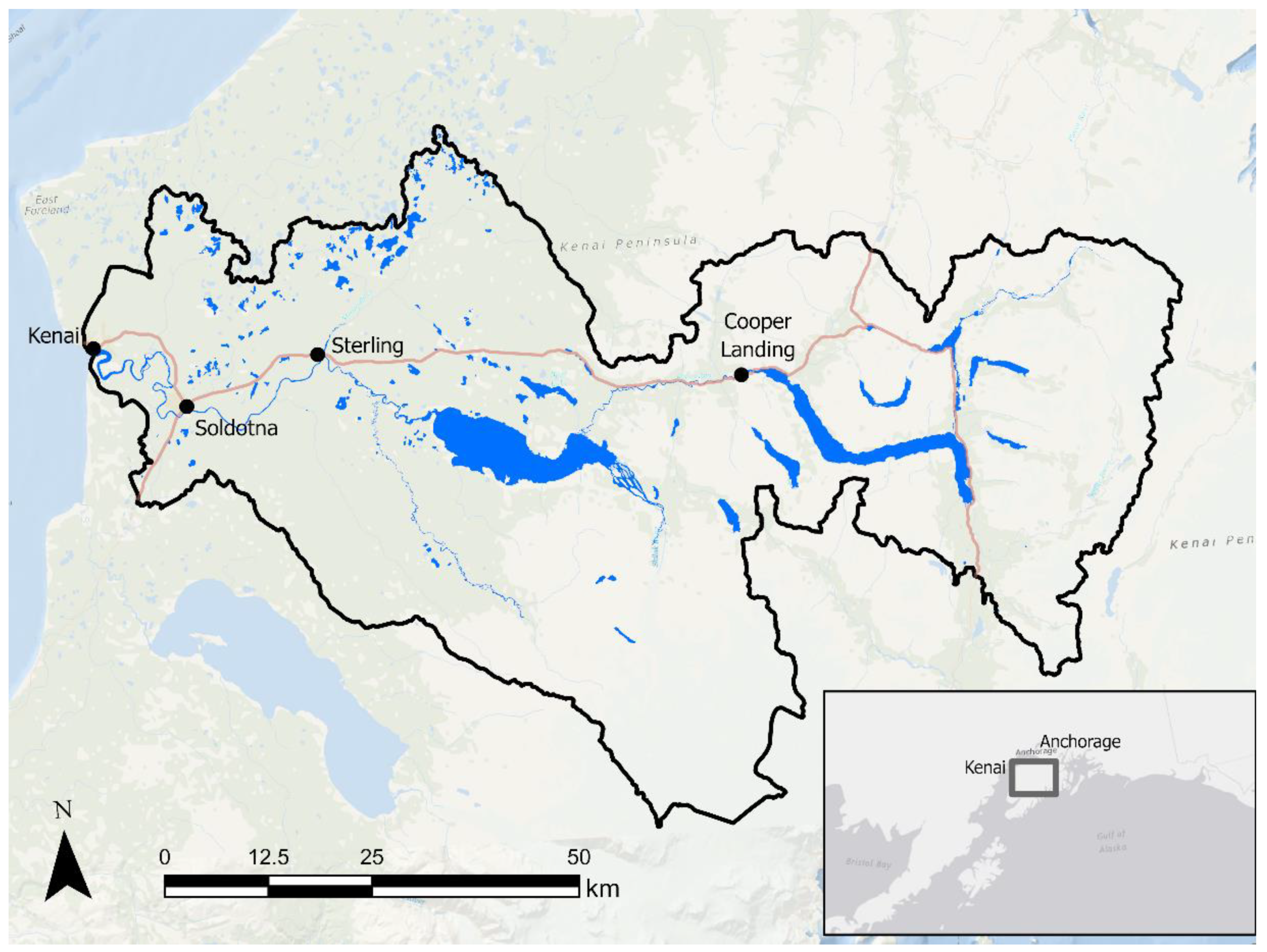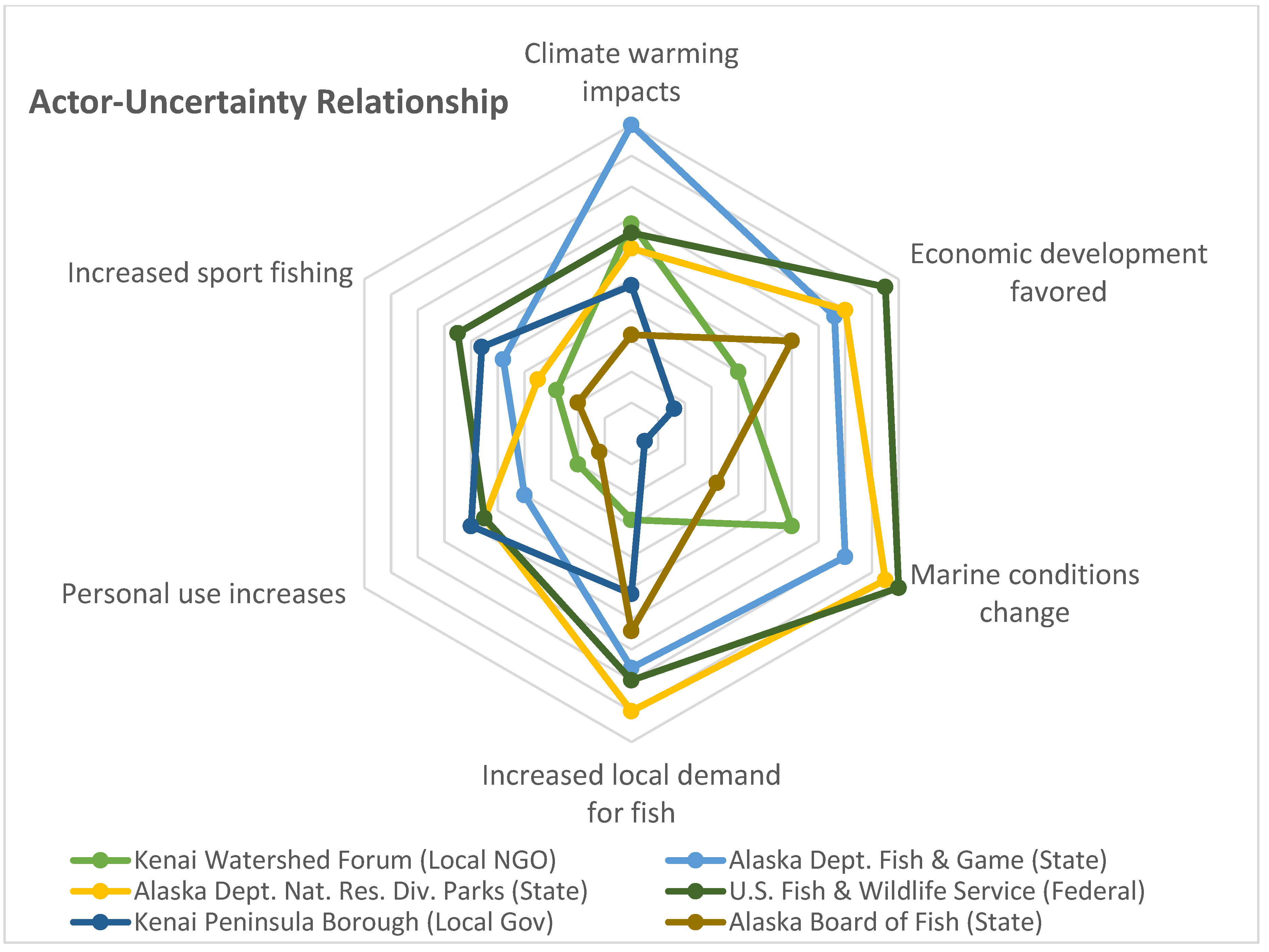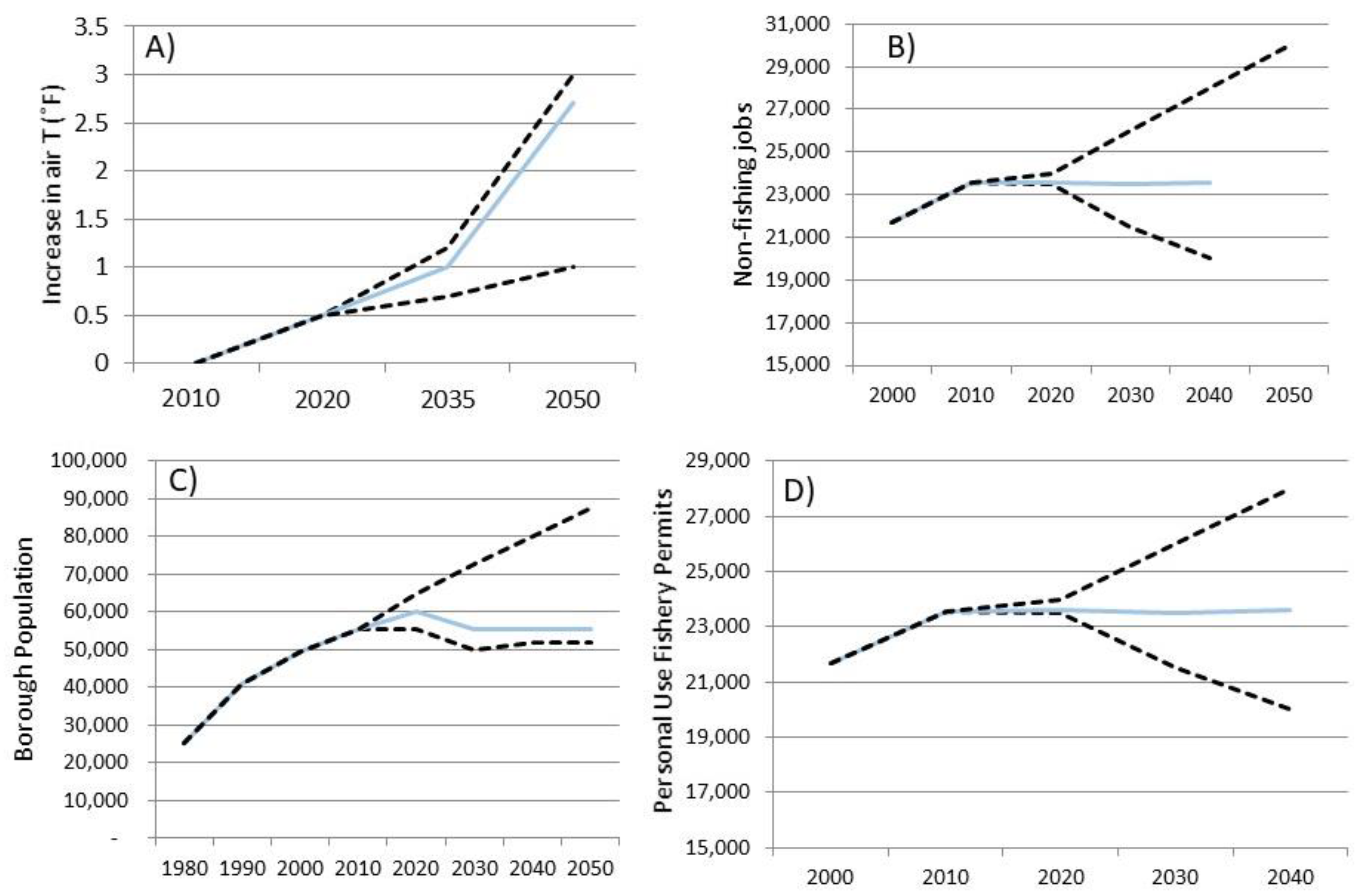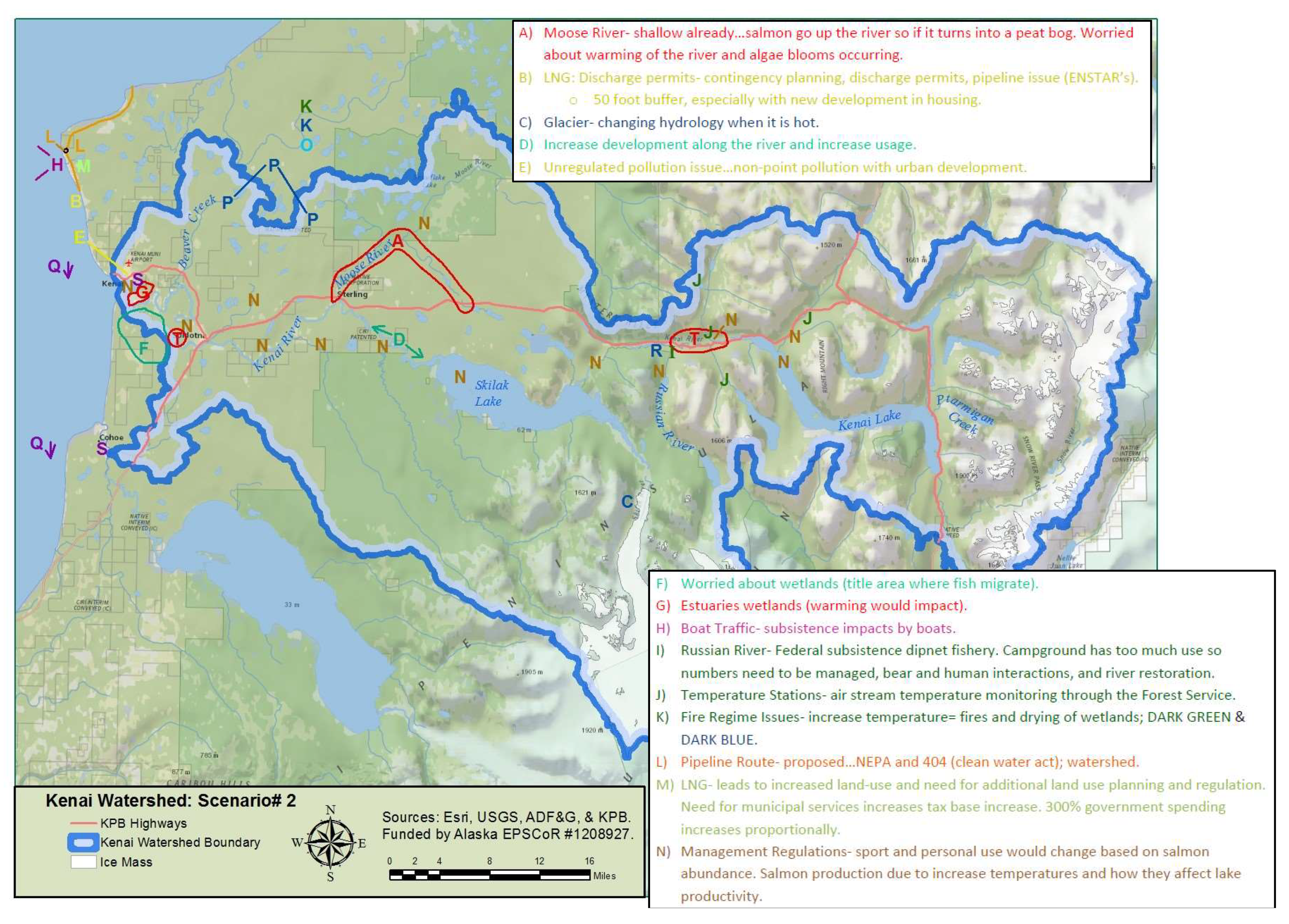Using Comprehensive Scenarios to Identify Social–Ecological Threats to Salmon in the Kenai River Watershed, Alaska
Abstract
1. Introduction
2. Materials and Methods
2.1. Study Area
2.2. Scenario Approach
3. Results
3.1. Stakeholder Workshops
3.2. Scenario Narratives
- Should we consider an uncertain climate future?
- Should we make habitat conservation a priority?
- Should we create a watershed plan that will pool resources, funding, and planning processes?
- 4.
- Will climate-induced stream temperature and hydrological regime changes harm Kenai salmon?
- 5.
- Will new economic pressures (land and energy development) affect protection of salmon resources?
- 6.
- Will fish availability decrease due to changing marine conditions?
- 7.
- Will population and land use changes in Southcentral Alaska increase demand for salmon?
- 8.
- Will participation in the personal use fishery continue to increase?
- 9.
- Will local population increases result in an increase in sport fishing?
4. Discussion
5. Conclusions
Author Contributions
Funding
Institutional Review Board Statement
Informed Consent Statement
Data Availability Statement
Acknowledgments
Conflicts of Interest
References
- Bienek, P.A.; Walsh, J.E.; Thoman, R.L.; Bhatt, U.S. Using Climate Divisions to Analyze Variations and Trends in Alaska Temperature and Precipitation. J. Clim. 2014, 27, 2800–2818. [Google Scholar] [CrossRef]
- Box, J.E.; Colgan, W.T.; Christensen, T.R.; Schmidt, N.M.; Lund, M.; Parmentier, F.J.; Brown, R.; Bhatt, U.S.; Euskirchen, E.N.S.; Romanovsky, V.E.; et al. Key Indicators of Arctic Climate Change: 1971–2017. Env. Res. Lett. 2019, 14, 045010. [Google Scholar] [CrossRef]
- Markon, C.; Gray, S.; Berman, M.; Eerkes-Medrano, L.; Hennessy, T.; Huntington, H.; Littell, J.; McCammon, M.; Thoman, R.; Trainor, S. Alaska. In Impacts, Risks, and Adaptation in the United States: Fourth National Climate Assessment; Reidmiller, D., Avery, C.W., Easterling, D.R., Kunkel, K.E., Lewis, K.L.M., Maycock, T.K., Stewart, B.C., Eds.; U.S. Global Change Research Program: Washington, DC, USA, 2018; Volume II, pp. 1185–1241. [Google Scholar] [CrossRef]
- Mauger, S.; Shaftel, R.; Leppi, J.C.; Rinella, D.J. Summer Temperature Regimes in South-Central Alaska Streams: Watershed Drivers of Variation and Potential Implications for Pacific Salmon. Can. J. Fish. Aq. Sci. 2017, 74, 702–715. [Google Scholar] [CrossRef]
- Josberger, E.G.; Bidlake, W.R.; March, R.S.; Kennedy, B.W. Glacier Mass-Balance Fluctuations in the Pacific Northwest and Alaska, USA. Ann. Glaciol. 2007, 46, 291–296. [Google Scholar] [CrossRef]
- Stuefer, S.L.; Arp, C.D.; Kane, D.L.; Liljedahl, A.K. Recent Extreme Runoff Observations from Coastal Arctic Watersheds in Alaska. Wat. Res. 2017, 53, 9145–9163. [Google Scholar] [CrossRef]
- Caissie, D. The Thermal Regime of Rivers: A Review. Freshw. Biol. 2006, 51, 1389–1406. [Google Scholar] [CrossRef]
- Burgmer, T.; Hillebrand, H.; Pfenninger, M. Effects of Climate-Driven Temperature Changes on the Diversity of Freshwater Macroinvertebrates. Oecologia 2007, 151, 93–103. [Google Scholar] [CrossRef]
- Brett, J.R.; Shelbourn, J.E.; Shoop, C.T. Growth Rate and Body Composition of Fingerling Sockeye Salmon, Oncorhynchus nerka, in Relation to Temperature and Ration Size. J. Fish. Res. B. Can. 1969, 26, 2363–2394. [Google Scholar] [CrossRef]
- Brannon, E. L Mechanisms Stabilizing Salmonid Fry Emergence Timing. Can. Sp. Pub. Fish. Aq. Sci. 1987, 96, 120–124. [Google Scholar]
- Quinn, T.P. The Behavior and Ecology of Pacific Salmon and Trout, 2nd ed.; The American Fisheries Society and University of Washington Press: Bethesda, MD, USA, 2005. [Google Scholar]
- Quinn, T.P.; Hodgson, S.; Peven, C. Temperature, Flow, and the Migration of Adult Sockeye Salmon (Oncorhynchus nerka) in the Columbia River. Can. J. Fish. Aquat. Sci. 1997, 54, 1349–1360. [Google Scholar] [CrossRef]
- Salinger, D.H.; Anderson, J.J. Effects of Water Temperature and Flow on Adult Salmon Migration Swim Speed and Delay. Trans. Am. Fish. Soc. 2006, 135, 188–199. [Google Scholar] [CrossRef]
- Fryer, J.L.; Pilcher, K.S. Effects of Temperature on Diseases of Salmonid Fishes; Ecological Research Series; EPA-660/3-73-020; US Environmental Protection Agency, Office of Research and Development: Washington, DC, USA, 1974; p. 20460. [Google Scholar]
- Kocan, R.; Hershberger, P.; Sanders, G.; Winton, J. Effects of Temperature on Disease Progression and Swimming Stamina in Ichthyophonus-Infected Rainbow Trout, Oncorhynchus mykiss (Walbaum). J. Fish. Dis. 2009, 32, 835–843. [Google Scholar] [CrossRef] [PubMed]
- Richter, A.; Kolmes, S.A. Maximum Temperature Limits for Chinook, Coho, and Chum Salmon, and Steelhead Trout in the Pacific Northwest. Res. Fis. Sci. 2005, 13, 23–49. [Google Scholar] [CrossRef]
- Ruggerone, G.T.; Peterman, R.M.; Dorner, B.; Myers, K.W. Magnitude and Trends in Abundance of Hatchery and Wild Pink Salmon, Chum Salmon and Sockeye Salmon in the North Pacific Ocean. Mar. Coast. Fish. 2010, 2, 306–328. [Google Scholar] [CrossRef]
- Gunderson, L.H.; Holling, C.S. Panarchy: Understanding Transformations in Human and Natural Systems; Island Press: Washington, DC, USA, 2002; ISBN 978-1559638579. [Google Scholar]
- Allen, C.R.; Gunderson, L.H. Pathology and Failure in the Design and Implementation of Adaptive Management. J. Environ. Manag. 2011, 92, 1379–1384. [Google Scholar] [CrossRef] [PubMed]
- Kliskey, A.; Alessa, L.; Wandersee, S.; Williams, P.; Trammell, J.; Powell, J.; Grunblatt, J.; Wipfli, M. A Science of Integration: Frameworks, Processes, and Products in a Place-based, Integrative Study. Sustain. Sci. 2016, 12, 293–303. [Google Scholar] [CrossRef]
- Postma, T.J.B.M.; Liebl, F. How to Improve Scenario Analysis as a Strategic Management Tool? Technol. Forecast. Soc. Chang. 2005, 72, 161–173. [Google Scholar] [CrossRef]
- Carpenter, S.R.; Bennett, E.M.; Peterson, G.D. Scenarios for Ecosystem Services: An Overview. Ecol. Soc. 2006, 11, 29. [Google Scholar] [CrossRef]
- Williams, P.; Alessa, L.; Kliskey, A.; Rinella, D.J.; Trammell, J.; Powell, J.; McCarthy, M.; Abatzoglou, J. The Role of Perceptions Versus Instrumented Data of Environmental Change: Responding to Changing Environments in Alaska. Environ. Sci. Policy 2018, 90, 110–121. [Google Scholar] [CrossRef]
- Walker, B.; Salt, D. Resilience Thinking: Sustaining Ecosystems and People in a Changing World; Island Press: Washington, DC, USA, 2006. [Google Scholar]
- Polasky, S.; Carpenter, S.R.; Folke, C.; Keeler, B. Decision-Making under Great Uncertainty: Environmental Management in an Era of Global Change. Trends Ecol. Evol. 2011, 26, 398–404. [Google Scholar] [CrossRef] [PubMed]
- Lein, J.K. Prediction, Uncertainty, and Environmental Sustainability. Future Res. Environ. Sustain. 2017, 45, 14. [Google Scholar]
- Peterson, G.D.; Cumming, G.S.; Carpenter, S.R. Scenario Planning: A Tool for Conservation in an Uncertain World. Conserv. Biol. 2003, 17, 358–366. [Google Scholar] [CrossRef]
- Kok, K.; van Delden, H. Combining Two Approaches of Integrated Scenario Development to Combat Desertification in the Guedalentin Watershed, Spain. Environ. Plan. B Plan. Des. 2009, 36, 49–66. [Google Scholar] [CrossRef]
- Trammell, E.J.; Thomas, J.S.; Mouat, D.; Korbulic, Q.; Bassett, S. Developing Alternative Land-Use Scenarios to Facilitate Natural Resource Management across Jurisdictional Boundaries. J. Environ. Plan. Manag. 2018, 61, 64–85. [Google Scholar] [CrossRef]
- Swart, R.J.; Raskin, P.; Robinson, J. The Problem of the Future: Sustainability Science and Scenario Analysis. Glob. Env. Change 2004, 14, 137–146. [Google Scholar] [CrossRef]
- Carpenter, S.R.; Booth, E.G.; Gillon, S.; Kucharik, C.J.; Loheide, S.; Mase, A.S.; Motew, M.; Qiu, J.; Rissman, A.R.; Siefert, J.; et al. Plausible Futures of a Social-Ecological System: Yahara Watershed, Wisconsin, USA. Ecol. Soc. 2015, 20, 10. [Google Scholar] [CrossRef]
- Huegens, P.M.A.R.; Van Oosterhout, J. To Boldly Go Where No Man Has Gone Before: Integrating Cognitive and Physical Features in Scenario Studies. Futures 2001, 33, 861–872. [Google Scholar] [CrossRef]
- Sala, O.E.; Chapin, S.F., III; Armesto, J.J.; Berlow, E.; Bloomfield, J.; Dirzo, R.; Huber-Sanwald, E.; Huenneke, L.F.; Jackson, R.B.; Kinzig, A.; et al. Global Biodiversity Scenarios for the Year 2100. Science 2000, 287, 1770–1774. [Google Scholar] [CrossRef] [PubMed]
- Brown, K.; Adger, W.N.; Tomkins, E.; Bacon, P.; Shim, D.; Shim, K. Trade-off Analysis for Marine-Protected Area Management. Ecol. Econ. 2001, 37, 417–434. [Google Scholar] [CrossRef]
- Kok, K.B.; Patel, M.; Rothma, D.S. Final Report of European and Mediterranean Scenarios: Upscaling the Results from the Target Area Scenarios; MedAction Deliverable 4; International Centre for Integrated Assessment and Sustainable Development (ICIS); Working Paper I04-E002; Maastricht University; Maastricht University: Maastricht, The Netherlands, 2004. [Google Scholar]
- Bradfield, R.; Wright, G.; Burt, G.; Cairns, G.; Van Der Heijden, K. The Origins and Evolution of Scenario Techniques in Long Range Business Planning. Futures 2005, 37, 795–812. [Google Scholar] [CrossRef]
- Pereira, E.; Queiroz, C.; Pereira, H.M.; Vicente, L. Ecosystem Services and Human Well Being: A Participatory Study in a Mountain Community in Portugal. Ecol. Soc. 2005, 10, 14. Available online: http://www.ecologyandsociety.org/vol10/iss2/art14/ (accessed on 11 May 2021). [CrossRef]
- Carpenter, S.R. Estimating dispersal from patterns of spread: Spatial and local control of lake invasions. Ecology 2002, 83, 2069–2083. [Google Scholar] [CrossRef]
- Gude, P.H.; Hansen, A.J.; Jones, D.A. Biodiversity Consequences of Alternative Future Land Use Scenarios in Greater Yellowstone. Ecol. App. 2007, 17, 1004–1018. [Google Scholar] [CrossRef] [PubMed]
- Wollenberg, E.; Edmunds, D.; Buck, L. Using Scenarios to Make Decisions About the Future: Anticipatory Learning for the Adaptive Co-Management of Community Forests. Lands. Urban Plan. 2000, 47, 65–77. [Google Scholar] [CrossRef]
- Mahmoud, M.; Liu, Y.; Hartmann, H.; Stewart, S.; Wagener, T.; Semmens, D.; Stewart, R.; Gupta, H.V.; Dominguez, D.; Hulse, D.; et al. A Formal Framework for Scenario Development in Support of Environmental Decision-Making. Environ. Model. Softw. 2009, 24, 798–808. [Google Scholar] [CrossRef]
- Oteros-Rozas, E.; Martin-Lopez, B.; Daw, T.M.; Bohensky, E.L.; Butler, J.R.A.; Hill, R.; Martin-Ortega, J.; Quinlan, A.; Ravera, F.; Ruiz-Mallen, I.; et al. Participatory Scenario Planning in Place-Based Social-Ecological Research: Insights and Experiences from 23 Cases Studies. Ecol. Soc. 2015, 20, 32. [Google Scholar] [CrossRef]
- Kahane, A. Transformative Scenario Planning. Working Together to Change the Future; Berrett-Koehler: San Francisco, CA, USA, 2012. [Google Scholar]
- Carlsen, H.; Dreborg, K.H.; Wikman-Svahn, P. Tailormade Scenario Planning for Local Adaptation to Climate Change. Mitig. Adapt. Strateg. Glob. Chang. 2013, 18, 1239–1255. [Google Scholar] [CrossRef]
- Cork, S.; Peterson, G.; Petschel-Held, G.; Alcamo, J.; Alder, J.; Bennett, E.; Carr, E. Ecosystems and Human Well-Being: Scenarios. In Millennium Ecosystem Assessment; Carpenter, S.R., Pingali, P.L., Bennett, E.M., Zurek, M.B., Eds.; Island Press: Washington, DC, USA, 2005; pp. 225–294. [Google Scholar]
- Bohensky, E.L.; Butler, J.R.A.; Mitchell, D. Scenarios for Knowledge Integration: Exploring Ecotourism Futures in Milne Bay, Papua, New Guinea. J. Mar. Biol. 2011, 2011, 504651. [Google Scholar] [CrossRef]
- Bohensky, E.; Butler, J.R.A.; Costanza, R.; Bohnet, I.; Delisle, A.; Fabricius, K.; Gooch, M.; Kubiszewski, I.; Lukacs, G.; Pert, P.; et al. Future Makers or Future Takers? A Scenario Analysis of Climate Change and the Great Barrier Reef. Glob. Environ. Chang. 2011, 21, 876–893. [Google Scholar] [CrossRef]
- Palomo, I.; Martín-López, B.; López-Santiago, C.; Montes, C. Participatory Scenario Planning for Protected Areas Management Under the Ecosystem Services Framework: The Doñana Social-Ecological System in Southwestern Spain. Ecol. Soc. 2011, 16, 23. Available online: http://www.ecologyandsociety.org/vol16/iss1/art23/ (accessed on 11 May 2021). [CrossRef]
- Butler, J.R.A.; Suadnya, W.; Puspadi, K.; Sutaryono, Y.; Wise, R.M.; Skewes, T.D.; Kirono, D.; Bohensky, E.L.; Handayani, T.; Haibi, P.; et al. Framing the Application of Adaptation Pathways for Rural Livelihoods and Global Change in Eastern Indonesian Islands. Glob. Environ. Chang. 2014, 28, 368–382. [Google Scholar] [CrossRef]
- Brunckhorst, D.; Trammell, E.J.; Shannon, M. Landscape loopholes: Moments for change. J. Res. Pract. 2017, 13, P1. [Google Scholar]
- U.S. Census. Available online: https://www.census.gov/ (accessed on 12 October 2015).
- Schoen, E.R.; Wipfli, M.S.; Trammell, E.J.; Rinella, D.J.; Floyd, A.L.; Grunblatt, J.; McCarthy, M.D.; Meyer, B.E.; Morton, J.M.; Powell, J.E.; et al. Future of Pacific Salmon in the Face of Environmental Change: Lessons from One of the World’s Remaining Productive Salmon Regions. Fisheries 2017, 42, 538–553. [Google Scholar] [CrossRef]
- Armstrong, M. Public Testimony on Anadromous Stream Ordinance Clear: Repeal It. Available online: https://www.homernews.com/news/public-testimony-on-anadromous-stream-ordinance-clear-repeal-it/ (accessed on 20 September 2019).
- Krupa, M.B. Who’s Who in T=the Kenai River Fishery SES: A Streamlined Method for Stakeholder Identification and Investment Analysis. Mar. Policy 2016, 71, 194–200. [Google Scholar] [CrossRef]
- Ellenwood, M.S.; Dilling, L.; Milford, J.B. Managing United States Public Land in Response to Climate Change: A View From the Ground Up. Environ. Manag. 2012, 49, 954–967. [Google Scholar] [CrossRef]
- Steinitz, C. A Framework for Geodesign: Changing Geography by Design, 1st ed.; Esri Press: Redlands, CA, USA, 2012; ISBN 9781589483330. [Google Scholar]
- Hoversten, M.E.; Swaffield, S.R. Discursive Moments: Reframing Deliberation and Decision-Making in Alternative Futures Landscape Ecological Planning. Landsc. Urban. Plan. 2019, 182, 22–33. [Google Scholar] [CrossRef]
- Shearer, A.W.; Mouat, D.A.; Bassett, S.D.; Binford, M.W.; Johnson, C.W.; Saarinen, J.A. Examining Development-Related Uncertainties for Environmental Management: Strategic Planning Scenarios in Southern California. Land. Urban Plan. 2006, 77, 359–381. [Google Scholar] [CrossRef]
- Krupa, M.; Cenek, M.; Powell, J.; Trammell, E.J. Mapping the Stakeholders: Using Social Network Analysis to Increase the Legitimacy and Transparency of Participatory Scenario Planning. Soc. Nat. Resour. 2018, 31, 136–141. [Google Scholar] [CrossRef]
- Alessa, L.; Altaweel, M.; Kliskey, A.; Bone, C.; Schnabel, W.; Stevenson, K. Alaska’s Freshwater Resources: Issues Affecting Local and International Interests. J. Am. Water Resour. Assoc. 2011, 47, 143–157. [Google Scholar] [CrossRef]
- Ruckelshaus, M.H.; Levin, P.; Johnson, J.B.; Kareiva, P.M. The Pacific Salmon Wars: What Science Brings to the Challenge of Recovering Species. Annu. Rev. Ecol. Syst. 2002, 33, 665–706. [Google Scholar] [CrossRef]
- Spijkers, J.; Merrie, A.; Wabnitz, C.C.C.; Osborne, M.; Mobjörk, M.; Bodin, Ö.; Selig, E.R.; Billon, P.L.; Hendrix, C.S.; Singh, G.G.; et al. Exploring the Future of Fishery Conflict through Narrative Scenarios. One Earth 2021, 4, 386–396. [Google Scholar] [CrossRef]
- Bryan, B.A.; Crossman, N.D.; King, D.; Meyer, W.S. Landscape Futures Analysis: Assessing the Impacts of Environmental Targets under Alternative Spatial Policy Options and Future Scenarios. Environ. Model. Softw. 2011, 26, 83–91. [Google Scholar] [CrossRef]
- Ellis, J.; Tiller, R. Conceptualizing Future Scenarios of Integrated Multi-Trophic Aquaculture (IMTA) in the Norwegian Salmon Industry. Mar. Policy 2019, 104, 198–209. [Google Scholar] [CrossRef]
- Vadenbo, C.; Tonini, D.; Burg, V.; Astrup, T.F.; Thees, O.; Hellweg, S. Environmental Optimization of Biomass Use for Energy under Alternative Future Energy Scenarios for Switzerland. Biomass Bioenergy 2018, 119, 462–472. [Google Scholar] [CrossRef]




| Scenario | Climate Change | Economic Development | Marine Conditions | Local Demand | Personal Use | Sport Fishing |
|---|---|---|---|---|---|---|
| Scenario 1 (Retirement Paradise) | Moderate increases in stream temp | Increase in retirement housing and industry | Negligible change | Moderate increase | Decrease | Large increase |
| Scenario 2 (Industrial Boom) | Large increase in stream temperature, less water available | Increase in industrial development | Negligible change | Slight increase | Negligible change | Large decrease |
| Scenario 3 (More People More Fish) | Negligible change | Increase in residential housing | Negligible change | Large increase | Up a little, leveled off | Large increase |
| Scenario 4 (Ocean Crash) | Negligible change | Increase in industrial development | Colder ocean temps, less productive fishery | Slight decrease | Shut down | Large increase, new species focus |
| Scenario 5 (Fish for the Masses) | Large increase in stream temperature | Negligible change | More variable, hard to predict | Negligible changes | Significant increase | Negligible change |
Publisher’s Note: MDPI stays neutral with regard to jurisdictional claims in published maps and institutional affiliations. |
© 2021 by the authors. Licensee MDPI, Basel, Switzerland. This article is an open access article distributed under the terms and conditions of the Creative Commons Attribution (CC BY) license (https://creativecommons.org/licenses/by/4.0/).
Share and Cite
Trammell, J.; Krupa, M.; Williams, P.; Kliskey, A. Using Comprehensive Scenarios to Identify Social–Ecological Threats to Salmon in the Kenai River Watershed, Alaska. Sustainability 2021, 13, 5490. https://doi.org/10.3390/su13105490
Trammell J, Krupa M, Williams P, Kliskey A. Using Comprehensive Scenarios to Identify Social–Ecological Threats to Salmon in the Kenai River Watershed, Alaska. Sustainability. 2021; 13(10):5490. https://doi.org/10.3390/su13105490
Chicago/Turabian StyleTrammell, Jamie, Meagan Krupa, Paula Williams, and Andrew Kliskey. 2021. "Using Comprehensive Scenarios to Identify Social–Ecological Threats to Salmon in the Kenai River Watershed, Alaska" Sustainability 13, no. 10: 5490. https://doi.org/10.3390/su13105490
APA StyleTrammell, J., Krupa, M., Williams, P., & Kliskey, A. (2021). Using Comprehensive Scenarios to Identify Social–Ecological Threats to Salmon in the Kenai River Watershed, Alaska. Sustainability, 13(10), 5490. https://doi.org/10.3390/su13105490







